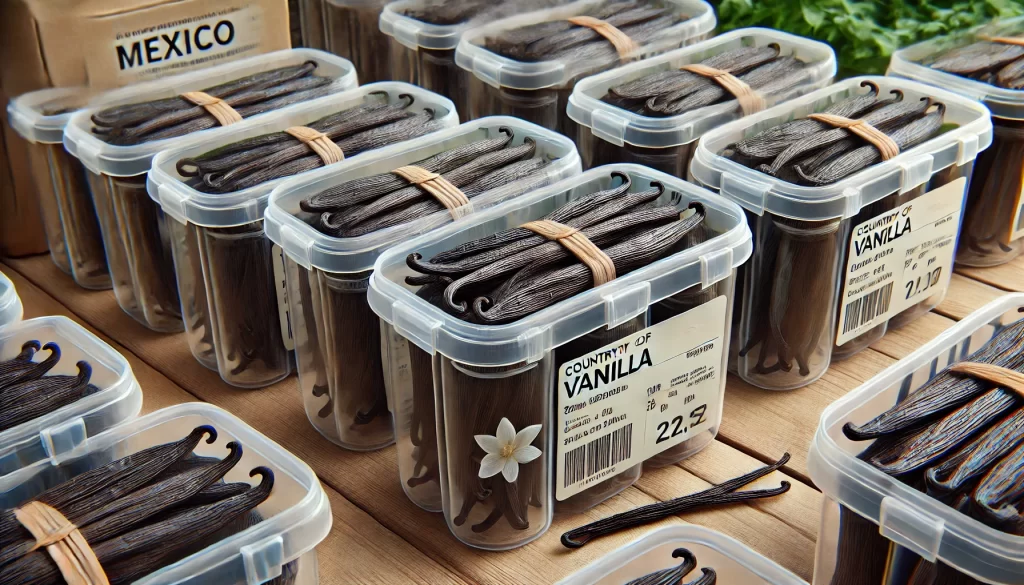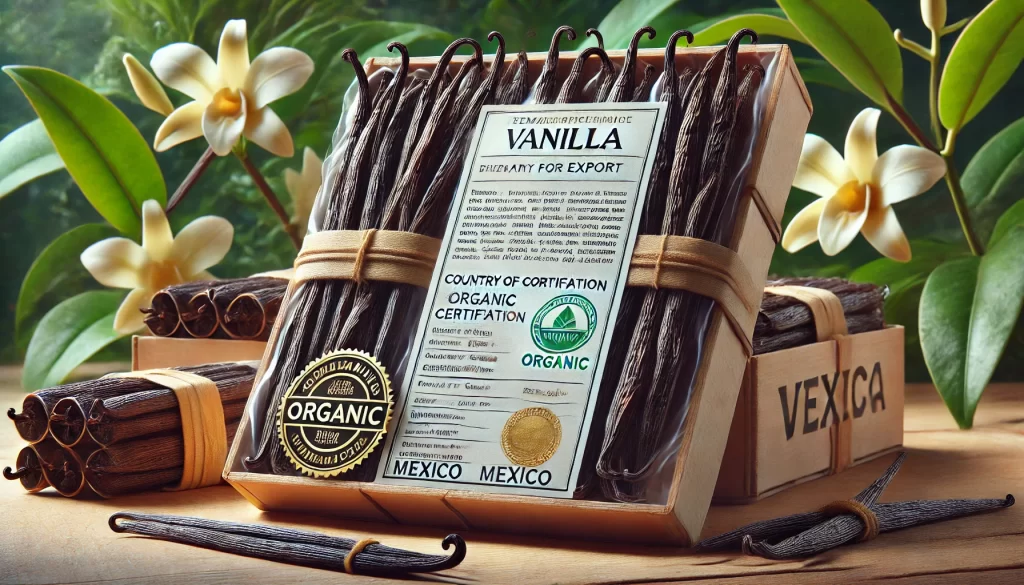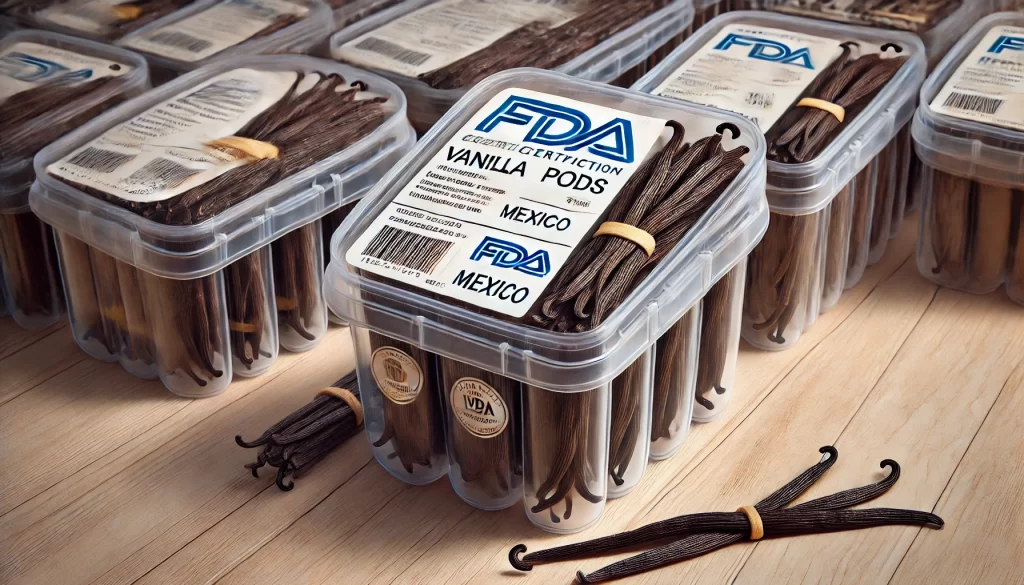Vanilla is one of the most cherished spices in the world, and Mexico, as the historical birthplace of Vanilla planifolia, plays a key role in its production and exportation. However, exporting vanilla faces strict legal, sanitary, and quality requirements, especially when targeting demanding markets like the United States. In this article, we will analyze the main international requirements and regulations for exporting vanilla, as well as the specific procedures for the U.S. market.

Mexico’s Importance in Vanilla Export
Mexico is considered the country of origin of vanilla and, although its production has decreased compared to countries like Madagascar or Indonesia, it remains a reference in terms of quality and flavor. The main producing states are Veracruz, Puebla, and Oaxaca. Mexican vanilla is highly valued in international markets due to its distinctive aromatic profile and its traditional curing methods.
General Requirements for Vanilla Export
Vanilla export is subject to international regulations and specific requirements of the destination country. Below, the most important requirements are detailed:
Quality Certifications
- International Quality Standards: Vanilla must meet standards such as ISO 5565-1 and ISO 5565-2, which regulate quality parameters, aroma, humidity, and purity.
- Organic Certifications: More and more consumers prefer products certified as organic. Certifications such as USDA Organic and Fair Trade can open doors in premium markets.
Phytosanitary Requirements
- International Phytosanitary Certificate: Issued by the SENASICA (National Service for Agri-Food Health, Safety and Quality) in Mexico, this certificate guarantees that the vanilla is free of pests and diseases.
- Product Inspection: The pods must undergo phytosanitary controls before export to prevent the entry of pathogenic organisms into the destination country.

Packaging and Labeling
- Appropriate packaging material: The packaging must protect the vanilla during transport, avoiding damage and contamination.
- Mandatory information on the label:
- Product name
- Country of origin (Mexico)
- Producer/exporter information
- Harvest and curing date
- Certifications, if any
Necessary Documentation
- Phytosanitary certificate
- Commercial invoice
- Packing list
- Customs documentation
- Registration with regulatory entities (such as the FDA in the U.S.)
Regulations for Exporting Vanilla to the United States
The U.S. market is one of the largest consumers of vanilla worldwide. Exporting to this country requires compliance with specific regulations established by agencies such as the FDA (Food and Drug Administration) and the USDA (U.S. Department of Agriculture).
FDA Registration
- All producers and exporters must be registered with the FDA.
- Compliance with the Food Safety Modernization Act (FSMA) is required, which mandates a preventive control plan to reduce risks in production and transportation.

USDA-APHIS Phytosanitary Certificate
- The USDA-APHIS (Animal and Plant Health Inspection Service) requires a phytosanitary certificate issued by SENASICA in Mexico.
- The pods must be free of pests and diseases.
Labeling Standards
- Labeling must comply with FDA provisions.
- All information must be in English and must include data about origin, ingredients, and exporter contact information.
Vanilla Quality Standards
- The pods must meet the moisture, aroma, and quality specifications established in the Código de Regulaciones Federales (CFR) of the U.S.
- Tests are conducted to verify that the pods do not contain pesticide residues or contaminants.
Step-by-Step Process to Export Vanilla from Mexico to the United States
- Market Analysis: Research the demand for vanilla and the specific requirements of buyers in the U.S.
- Phytosanitary Certification: Obtain the phytosanitary certificate issued by SENASICA.
- FDA Registration: Register the producer/exporter in the FDA system.
- Product Preparation: Select high-quality pods, cure them correctly, and pack them according to regulations.
- Correct Labeling: Ensure that the labeling complies with FDA requirements.
- Customs Clearance: Carry out customs procedures in Mexico and the U.S. with a specialized agent.
- Transport Logistics: Ensure optimal conditions during transport to avoid damage to the pods.
- Delivery to the Final Customer: Verify the product’s receipt and customer satisfaction.

Challenges in Vanilla Export
- High production costs: Especially due to manual pollination and the curing process.
- Phytosanitary risks: Pests and diseases can delay or prohibit entry into the U.S. market.
- Tariff and bureaucratic barriers: Customs regulations can be complex and costly.
- Global competition: Madagascar, Indonesia, and Uganda are strong competitors in the vanilla market.
Opportunities for Mexican Exporters
- Value added: Organic and fair trade certifications can improve positioning.
- Premium quality: Mexican vanilla is globally recognized for its aromatic quality.
- Market diversification: In addition to the U.S., European and Asian markets offer growing opportunities.
The export of vanilla from Mexico to the United States requires compliance with strict phytosanitary, quality, and labeling regulations. However, the effort is worthwhile, as the global demand for premium vanilla continues to grow. Producers and exporters who manage to adapt to these requirements will not only help strengthen the Mexican vanilla industry but also gain access to lucrative and sustainable international markets.
 AgronoBlog – Agriculture Blog
AgronoBlog – Agriculture Blog 


